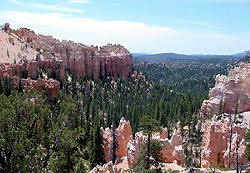 Swamp
Canyon appears relatively small and sheltered from the overlook, bounded
on both sides by fins and hoodoos. This size allows the viewer to develop
a more intimate connection with the landscape than some of the grander
viewpoints may provide. Swamp
Canyon appears relatively small and sheltered from the overlook, bounded
on both sides by fins and hoodoos. This size allows the viewer to develop
a more intimate connection with the landscape than some of the grander
viewpoints may provide.Geology
Looking south, Mud and Noon Canyon Buttes can be seen. Buttes are half way
along the erosional continuum between plateau and pinnacle. Plateaus are
large regions of uplifted land. Mesas are isolated portions of plateaus
that although much smaller than plateaus are still wider than they are
tall. As mesas erode they give birth to buttes, which are square shaped
being approximately the same width as they are tall. As buttes erode still
further they spawn spires of rocks.
At Bryce, our spires, known as
hoodoos,
are of a very special variety. The classic way a hoodoo forms begins with
a narrow fin
of rock that eventually develops holes or
windows.
As the windows grow they become arches. Eventually arches become too large
to support their roofs. The inevitable collapse of a window leaves behind
two broken legs of the arch. At Bryce we call broken arches hoodoos.
Nature
Many people assume that Swamp Canyon must be a misnomer. Although it might
be the last place on Earth you would expect to find an alligator, compared
to the rest of the park it is a virtual wetland. Here, below the rim, two
tiny creeks and a spring provide enough water to sustain more lush
vegetation like grasses and willows. This canyon remains wet enough year
around that it is also home to Tiger Salamanders and Missouri Iris.
Birdwatchers enjoy hiking the Swamp Canyon Loop Trail as it traverses four
distinctly different habitats offering the chance to see a wide diversity
of songbirds.
Trails
Two connecting trails can be found here, leading hikers to the
Under-the-Rim trail and several backcountry camping sites. More
information on backcountry hiking and camping is available at the visitor
center. Alternatively these two connecting trails can be combined to form
the 4.3-mile Swamp
Canyon Loop Trail.
Services
None
|

